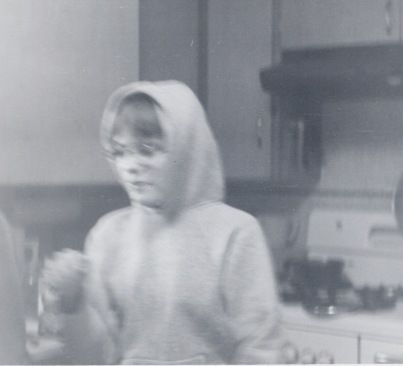Today’s Flyover People column as seen in The Emporia Gazette:
 One of many blurry photos I took in junior high. After track practice in 8th grade, Donna Smith Boese and other friends came over to my house.
One of many blurry photos I took in junior high. After track practice in 8th grade, Donna Smith Boese and other friends came over to my house.
THE VIEWFINDER
Do you know what I miss? I miss having a viewfinder.
I have to admit, taking photographs is easier with my phone than using a real camera. I don’t have to close one eye and peer through that tiny viewfinder. And I hardly even have to aim. Point, and shoot. And later, using a handy phone app, I can crop the photo to meet my needs.
Things were much different back in the olden days when I used an actual camera, one with film.
My interest in photography began when my brother took up the hobby. As Leon’s little sister and biggest fan, I wanted to do whatever he did.
One September evening in 1972, during my eighth grade year, I took our family’s Brownie camera to the junior high football game. I shot some blurry far-off photos of the game, but mostly I took blurry pictures of my friends acting like their 13-year-old selves.
A few years later when my brother upgraded, I inherited his single-lens reflex camera. Leon taught me how to roll my own 35 mm black-and-white film, develop it, and how to print photographs in his darkroom.
After Leon left for college, I took his place on football sidelines and under the basketball hoop, that heavy camera hanging around my neck. And like my brother once had, I stayed up until 2 a.m. Saturday mornings printing Friday night sports photos. I mailed them to Larned before noon on Saturday and they were published in Monday afternoon’s Tiller & Toiler newspaper.
During my high school years, my mom and I occasionally took rides in the country. This tradition began when she taught me how to drive at age 13, but the Saturday afternoon trips continued until I graduated. We drove around Barton, Rush, Pawnee and Edwards Counties.
I started taking my camera along on these car trips with Mom. Although I had been on many country rides in my life, it was on these Saturday drives, with stops to look through a viewfinder, that I began to see Kansas as beautiful, Kansas as art.
Near Hoisington, at a tiny ghost town named Boyd, I photographed what was left of an old gas station with its glass-topped vertical pumps.
In Rush County, Post Rock country, I photographed limestone fence posts with barbed wire wrapped around or running through the posts. And out in the sand hills of Edwards County, I photographed a weathered barn and sunflowers.
Everything was in black-and-white, but I learned I could use a polarizing filter and pull some incredible clouds out of the sky.
I had that camera against my face for pretty much my last three years in high school. And an odd thing began to happen. Even when I wasn’t holding a camera, my mind would create its own viewfinder. I’d scan the horizon and my eyes, trained to the rectangular frame, naturally searched for the shot I would take if I had my camera.
You’d think that a tiny rectangle would be very limiting, after all, there’s this whole big world around you, but you can include only one small portion of it in your photo.
As in life, however, sometimes limitation can be your best friend. If you have or do too much, life becomes full of distraction and clutter, and lacking an obvious focal point.
With a photo, you’re allowed one rectangle of space at a time – but you can put whatever you choose into that frame.
It’s all well and good to see the big picture, but sometimes it helps to narrow one’s focus, pay attention to the light, and take the best shot we can.
Copyright 2014 ~ Cheryl Unruh
Not many people know where Boyd is!! Thanks, once again, for a walk down memory lane.
Wonderful!
Great piece!